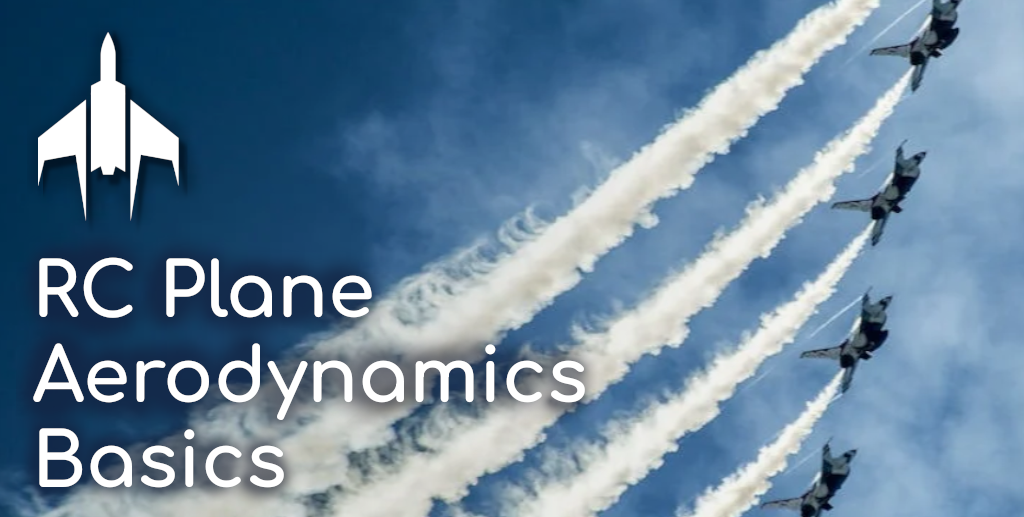Welcome to the fascinating world of RC (Radio-Controlled) plane aerodynamics. Embarking on a journey into the skies with these miniature aircraft requires a solid understanding of the fundamental principles that govern their flight.
From the graceful glide of a glider to the exhilarating loops of an acrobatic plane, every maneuver and flight characteristic is a result of intricate aerodynamic interactions.
In this introductory article, we take a look at some of the basic concepts that RC aircraft designers should be aware of.
Whether you’re a novice seeking to soar for the first time or a seasoned pilot aiming to refine your skills, a grasp of these aerodynamic basics will undoubtedly propel your RC flying experience to new heights.
So, fasten your seatbelt, adjust your trim tabs, and prepare to explore some of the basic principles that make RC planes take flight with grace and precision.
Wing Loading
What is Wing Loading?
Wing loading, or Wing Area Loading (WAL), is the ratio between the mass of a plane and its total wing area. It represents how much mass must be lifted per unit area of the wings, or how ‘heavy’ an RC plane is.
A low WAL means the plane is light and generally easier to fly, while a high WAL means the plane is heavy and can potentially be prone to stalling when the pilot makes flying errors.
Wing loading is a reasonable measure of how an RC plane of a certain size will behave in the air compared to another. A plane with low wing loading (low mass and large wing area) will be able to stay airborne at lower airspeeds, but will be more affected by gusts of air from different directions. A plane with high wing loading (higher mass and smaller wing area) must move faster to stay in the air without stalling, but is able to penetrate airflow from different directions more easily.
Wing Area Loading can give a good estimate of how difficult a plane is to fly when compared to another plane of similar size. In order to compare planes of different sizes, Wing Cube Loading is used (see below).
How do you calculate the wing loading for RC planes?
Wing loading for RC planes is calculated by dividing the plane’s total mass by the total wing area of both wings.

What is an acceptable wing loading for an RC plane?
This will depend largely on the RC plane’s size. A general rule of thumb for smaller planes below 1/4-scale is to not exceed 20 oz/sqft (6.1 kg/m2). 15 oz/sqft is a typical wing loading for trainers and 3D acrobatics planes.
Lighter planes that approach 10 oz/sqft or below may be much easier to fly in normal conditions, as they are less punishing with flying errors and can both takeoff and land at lower airspeeds.
A more appropriate metric for determining how easy an RC plane is to fly is Wing Cube Loading.
What is Wing Cube Loading?
Wing Cube Loading (WCL) is a more effective metric for comparing the flight behavior of different RC planes of different sizes. The WCL value is independent of an RC plane’s size, and therefore is a good number for estimating how difficult a plane will be to fly.
How do I calculate Wing Cube Loading for an RC Plane?
To calculate Wing Cube Loading for an RC plane, the following formula is used:

What is an acceptable Wing Cube Loading for an RC plane?
The values for WCL can be divided up into rough categories:
- 0 – 2.99 Indoor or very light wind
- 3 – 4.99 Backyard
- 5 – 6.99 Park flyers and 3D acrobatics.
- 7 – 9.99 Sport and trainers
- 10 – 13.99 Advanced sport and sport warbirds.
- 14 – 16.99 Expert sport and scale warbirds.
- 17+ Advanced Expert and true-scale planes or warbirds.
As the WCL number increases, the corresponding need for pilot skill increases, making WCL a good metric for a plane’s flying difficulty. Larger WCL mean the plane is heavy relative to its wings and must maintain higher airspeed to avoid stalling. The higher the WCL number, the more punishing the RC plane will be on pilot error.
Lift and Drag
What is Lift?
Lift refers to the force acting on a plane’s wing that is at 90° (perpendicular) to the flow direction of the air relative to the plane. In simple terms, it is the “upwards” force on a plane wing that allows the plane to stay airborne.
Lift occurs when an object, such as a plane, moves through a fluid (liquid or gas) and displaces fluid particles. Consistent with Newton’s Third Law of action and reaction, a force is imparted on the moving object relative to the change in fluid flow. Therefore, all that is needed to generate lift is relative fluid motion and an object shape or orientation that causes the displaced fluid to give an ‘upwards’ reaction force on the object.
The more fluid particles that are displaced per unit time, the more reaction force is exerted on the object and the more lift is generated. More airflow means more lift. In terms of airplanes, this means more speed means more lift.
Higher altitude also means less lift, since the air becomes thinner and there are fewer air particles to create the reaction forces. The maximum performance of an aircraft therefore depends both on its altitude and maximum airspeed or thrust.
How fast to RC planes go?
Common trainer RC planes check in at around 45 to 55 mph, with some reaching 60 mph. This is by no means a limit on RC plane speed however. Model jets that utilize internal combustion jet engines are capable of approaching 200 mph or more. In the right conditions and with sufficient altitude, even a glider can exceed 500 mph with little more than gravity to give it energy.
The available speed of an RC airplane will depend on the conditions of flight and the size or power of the engine or motor. Speed is also often limited by the physical limits of the airframe. A durable aircraft made from high-strength lightweight material is able to withstand the the higher aerodynamic forces associated with high-speed maneuvers.
How do you calculate Lift for an RC plane?
To calculate the lift of an RC plane, the lift equation is used:

Where:
- L is the total lift force
- ρ is air density
- v is the plane velocity or “true airspeed”
- S is the wing area
- CL is the lift coefficient
The lift coefficient C_L is the most complicated part of the lift equation. It depends on many factors such as the cross sectional-shape of the wing, angle of attack (AOA), airspeed, and Reynolds Number.
Aerospace companies usually determine the lift coefficient of an aircraft empirically through wind-tunnel testing, but there are some useful analytical methods for estimating it. These methods will be useful for RC airplane design and will be looked at in future articles.
What is Drag?
Drag refers to the force that resists a plane’s motion as it travels through air. Whereas lift always acts at 90° degrees to the plane’s direction of motion, Drag always acts at 180° or backwards. In simple terms, Drag is the force that is trying to slow the plane down.
How do you calculate Drag for an RC plane?
Drag can be calculated for an RC plane using the drag equation, which looks very similar to the lift equation:

Where:
- FD is the Drag Force acting at 180° to the direction of motion
- ρ is the air density
- v is the airspeed
- CD is the drag coefficient
- A is the cross-sectional area of the plane
As with the lift equation, the drag coefficient C_D is the most complicated part of the equation that depends on many factors. Luckily, there are also analytical methods for estimating the drag coefficient just like the lift coefficient. These will also be looked at in a future article.
Airfoils
What is an Airfoil?
An airfoil refers to an object that has a shape that allows it to generate significantly more lift than drag when moving through a fluid. As implied in the name, the fluid airfoils are designed for is air. Foils designed for liquid mediums are referred to as hydrofoils, but for RC planes the airfoil is what we are interested in. Airfoils are usually described and classified by their 2D cross-sectional shape, and there are many of them.
A good website for looking up airfoils is airfoiltools.com.
Do all RC airplanes have the same wing shape?
Airplanes do not have exactly the same wing shape, but they almost always have the same general shape of an airfoil. This is because the general airfoil shape is the most effective at generating lift and minimizing drag while moving through air. This principle also applies to RC planes.
Different families of airfoil have different advantages and disadvantages in different applications. The airfoil of a glider, for example, will be quite different to the airfoil of a commercial airliner. Some airfoil types include:
- Symmetrical & Semi-Symmetrical
- Flat-bottom and modified flat-bottom
- Under-cambered
- Reflex
What type of airfoil should you use for an RC plane?
Although there are a large number of specific airfoils in existence, for RC planes it will be good enough to select any airfoil from a general airfoil family that is suitable for your objectives. The airfoil family chosen will depend on the plane’s intended purpose. Airfoils are often tested to aerospace industry standards for use in full-scale airplanes, and these results are not always directly applicable at the RC scale. However, general differences between airfoil families are roughly applicable at the RC scale.
A general rule of thumb to use is that planes intended for 3D aerobatics make best use of a symmetrical airfoil, while planes intended for slower flight or carrying load should have “modified” flat-bottomed or under-cambered airfoils.
For basic flight, something like the non-symmetrical NACA 2415 works well for RC planes. The NACA 00 series, such as NACA 0012, are a range of symmetrical airfoils that are appropriate for planes designed for 3D aerobatics.
The Clark-Y is also a well-studied semi-flat-bottom airfoil and is often used in RC planes for general-purpose flying. This is an old airfoil design, however, that was used in various aircraft in the 1920’s and 30’s, but it is suitable for general-purpose flying.
Closing Comments
The information in this article barely scratches the surface of the deep field of engineering that is aerodynamics, but it takes a quick look at some of the main topics that are relevant to RC airplane design basics. A lot of the information available in the RC airplane community is based on years of trial and error by experienced RC pilots, and we can benefit from their accumulated knowledge.
The overall message from the RC aircraft community is that it’s hard to go wrong in an environment where extreme precision and optimization is not needed. The best approach is to just try things out with the knowledge available and find out what works.


